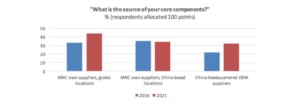What is OEM? The abbreviation “OEM” stands for original equipment manufacturer. The OEM definition can be misleading, as an OEM manufacturing does produce the product or components but they are created based on the design specifications produced by the original company.
The part an OEM manufacturing firm plays is purely the manufacturing aspect, and allows both companies to benefit from each other’s strengths. It can be one kind of possible solution in the procurement or sourcing process, respectively.
In many cases, a company does not have the required setup to produce highly specialized and high volume goods themselves–or outsourcing the production is simply much cheaper. By engaging in the services offered by OEMs, they can make use of external production capacities.
There is a similar term referred to as “ODM” which means original design manufacturer. This is when the manufacturer also creates the design and specifications themselves, often by producing a blank product (white label or private label) that you can rebrand to sell as your own. Therefore, the difference between OEM and ODM is that ODM production goes further than OEM manufacturing in terms of the degree of outsourcing.
In OEM contracts, the client usually commissions the supplier to manufacture product components, parts, or a subsystem according to the client’s desired design specifications, rather than full products. These product components are then delivered to the client for assembly or one of the OEM parts suppliers also takes over the final assembly.
Upon affixing the company trademark on these finished products, the client thereafter sells them in the market under its own name, often at competitive prices due to the reduced costs incurred in OEM manufacturing.
OEM manufacturing solutions traditionally offer cost-effective benefits to multinational corporations (MNCs) with large-scale order requirements, but OEM production is also becoming popular among smaller clients.
This is because OEM solutions are ideal for start-ups which–although adept at design and invention–lack the means or expertise to establish their own factory production domestically or in overseas (such as China), where skilled labor and supply chains are abundant at reduced costs. Globalization has made it much easier for small and medium-sized enterprises (SMEs) to also benefit from this option.
Common product categories in the OEM industry include those that have high volume outputs and some degree of product differentiation such as automotive industry, plastic parts, garments, toys, cosmetics, electronics and information communication technology (ICT) equipment.
Realize your own product ideas with the help of one or more manufacturers –
the basic principle of OEM production.
Advantages and Disadvantages of OEM Manufacturing
The first main advantage you receive when going down the OEM manufacturing route is that you generally receive cost effective products. You effectively benefit from the economies of scale as the supplier will be creating bulk amounts of goods to sell to you and that are similar to others. Furthermore, in OEM manufacturing, you often receive high quality goods, as they are tested according to the strict specialized manufacturer’s testing standards. Third party consulting companies can help you to find suitable OEM manufacture companies.
You also get to benefit from the specialized technology that OEMs provide. For example, a car manufacturer such as Ford or VW may use specialized components of another company within their cars that they themselves do not have the technology or expertise to create.
Also, you keep all trademarks and intellectual property rights associated with your design and products. Since your company is designing the components to be made, all associated rights belong to you.
On top of this, you also benefit from an efficient professional service. Generally, an OEM manufacturing company can only survive if it sustains the demand for a certain product category by being sufficiently good at it. Companies as customers are usually more demanding than consumers.
By entering into an agreement with an OEM manufacturing firm you are outsourcing the job of production. With the process of mostly being more efficient than doing it yourself, you ultimately benefit from lower prices, higher quality andspecialized goods, as well as more time to focus on core operations.
However, there are some disadvantages, since you may find that the selection of OEM suppliers for very special items is relatively small and takes time to establish, not allowing you a good opportunity to capitalize quickly on very new or innovative products. Requesting samples can clarify this issue.
Furthermore, since most OEM firms only like to deal with companies who can create a lot of demand, you might not be able to go down the OEM manufacturing route if you can’t sell enough products. Additionally, you are opening yourself up to the risks of having your intellectual property rights (IPRs) infringed and stolen because you have created the design for the components, which could be sold to competitors.
If you have registered all appropriate rights within China you do still have some protection that can be enforced, but that may still not stop some companies.
OEM production allows you to leave the actual production part to companies
with experience in this field.
Main Industries for OEM Manufacturing
There are several large industries that continuously benefit from outsourcing production to several different OEM manufacturing firms. The automotive sector is heavily linked to OEM production. Since there can be around 30,000 different parts in a car, it makes sense for manufacturers to outsource production of certain components to specialists.
This logic applies to many industries with complex products, which can be broken down inrelatively similar components across different manufacturers.
The electronics industry also heavily benefits from OEM manufacturing firms, with a perfect case being seen in Apple. Apple designs their product ranges; however, they are in a partnership with OEM manufacturing company Foxconn, who actually oversees the production in China.
When you think about the company that Apple is, you often think about their brilliance of innovation, sleek products andtheir marketing as things they excel in. They are not known and do not have the facilities in place to manufacture the millions of iPhones they sell every year.
That is why their partnership with OEM manufacturing company Foxconn makes sense; since they can reduce the time it takes to get products onto the market, it does not require heavy investment in machinery, and allows them to focus more time on what they do best.
In turn, these electronics products are overall sufficiently similar across different manufacturers so that Foxconn can produce for Samsung, LG, Hewlett-Packard and many others as well to gain expertise and hence improve efficiency.
OEM Manufacturing in China
OEM agreements, while also used within a single country, are more prevalent in transnational arrangements, where the client and the OEM supplier are situated in different countries. The main reason is that different countries have supply chain advantages in different product categories to manufacture components that are then sent elsewhere.
Most commonly, well-known Western companies such as Apple, IBM, Walmart, Nike and Cisco, for instance, frequently outsource their large volume OEM supplies to Asia. The majority of these bulk OEM orders are famously made in China. Also called Asia’s very own Silicon VaIley of hardware, Shenzhen in China is the most cost-effective choice for electronics OEM services. Other parts of the country, such as the coastal provinces around Shanghai, are know for the their OEM clothing manufacturers.
With over 10,000 OEM suppliers in Guangdong province alone, it boasts of extensive and advanced production capabilities, making it extremely attractive to global brands which seek to capitalize on its OEM industry’s core strengths—sophisticated supply chain networks, tech-savvyand experienced manufacturers at relatively lower labor costs.
MNCs prefer to outsource product component production to Chinese OEM manufacturers because of their enhanced capabilities (skills and technology-wise) that are at par with global standards and the government’s strong support for the OEM industry.
Since this development is going on for decades, their experience plays more and more a decisive role. Rising labor costs can often be offset by automation.
Why Product Development is Outsourced to China

Furthermore, according to Consultancy UK, MNCs are likely to even increase their sourcing of core components from China-based OEM suppliers in the future, with the latter’s total supply share in core components expected to increase by 10 percentage points from 22% to 32%. Low manufacturing cost are not the main reason for this development as the chart above shows.
The trend for increased OEM production in China is confirmed by McKinsey. They analyzed the trend in terms of the bill of materials (BOM). MNCs are planning to increase sourcing from China-headquartered OEM suppliers also in terms of the BOM by 10 percentage points from 20% to 30% over the next years.
Trend of MNCs Planning to Outsource More to OEM Suppliers in China

Both with respect to core components and considering the majority of all components, the clearest manufacturing trend is that MNC are planning to outsource more to independent China-headquartered OEM suppliers. The share of their own production locations in China (MNC own suppliers at China-based location) is expected to remain quite the same. According to McKinsey’s questionnaires, if this change happens until 2021, up to $50 billion of the market would shift in addition toward OEM suppliers whose headquarters are located in China.
Common Tasks in OEM Manufacturing
The scope of work for setting up OEM production typically includes:
Feasibility Study
Undertaking a large-scale OEM project without understanding the potential risks and costs involved can be very dangerous to your business. A feasibility analysis gives you a realistic insight on whether your business idea is worth pursuing and its potential for success.
It helps you to prevent project errors and risks as it helps you understand the manufacturing process of your product, capital requirements, startup costs and minimum order requirements. A feasibility project report likewise provides product costing and pricing by examining the practicality of an idea considering different materials and technical specifications.
Product Costing
Product costing entails precise approximations and neat breakdowns for critical cost aspects, including procurement of raw materials, prototyping, and assembly. It plays a crucial role in the profitability and eventual success of a business.
Because Asian companies handle components and materials different than their Western equivalents, it’s imperative that you keep track of the costs throughout the product lifecycle, from point of design conceptualization and prototype manufacturing all the way through production and shipment.
Product costing leads you to OEM production line companies with the best costing and pricing. By carefully assessing and optimizing your expenditures, you can have a cost-effective final production price for your product while still ensuring product profitability.
Contract Negotiations
One of the pitfalls of partnering with Chinese OEM production line companies is having a vaguely undescriptive contractual agreement between the parties. The root cause is often the failure of Westerners to understand Chinese business culture and legal systems.
In China, business contracts aren’t linked with specificity; instead, partnerships are simply anchored on long-standing relationships and mutual understanding.
This is where clear contractual negotiation comes in. Culturally sensitive negotiation strategies should be prioritized, so that the Chinese supplier better understands your specific needs and vice-versa while both parties form a mutually profitable business relationship. Still, it is important to have a legally binding and enforceable contract. These aspects have to be balanced.
As Chinese OEM suppliers rarely make concessions immediately without broader consultation, it is imperative to be patient in negotiating the best possible deal, identify areas of focused discussions while ensuring that legal clauses protective of your investment are written in your contractual agreement.
Lead Time Assessment
In OEM manufacturing, lead time of a single component largely impacts the whole supply chain process as it affects inventory schedules and stock replenishment of the whole good. Precise estimation of the manufacturing schedule, from initial stages of iterating product prototypes and order placement to packaging and delivery, is critical to avoid unnecessary delays.
Strategic lead time management helps monitor the production of OEM products strictly in time and significantly reduce the lead times so that you can launch your products in the market within the shortest time possible.
Prototyping
There are OEM production related companies that make prototypes, depending on your desired product specifications and initial design. During the rigorous iterative process, potential design flaws are identified early on to determine feasibility of your product for mass production.
Prototyping entails an honest evaluation of the potentials of customizing the new product based on your design files to align the product quality with projected costs. Reliable prototyping makes the production more efficient and fail-proof, allowing you to save time and money for product development. Mass production aspects should be considered early on.
OEM Packages
There are a few third party manufacturing consultancy companies offering end to end OEM manufacturing solutions. They can help if you need support with the whole process from prototyping to finding suitable suppliers for the different components and even arranging logistics.
These OEM packages can be broken down into different industries, since the manufacturing processes and the best OEM sourcing places differ with respect to product categories such as garments, plastics or electronics.







